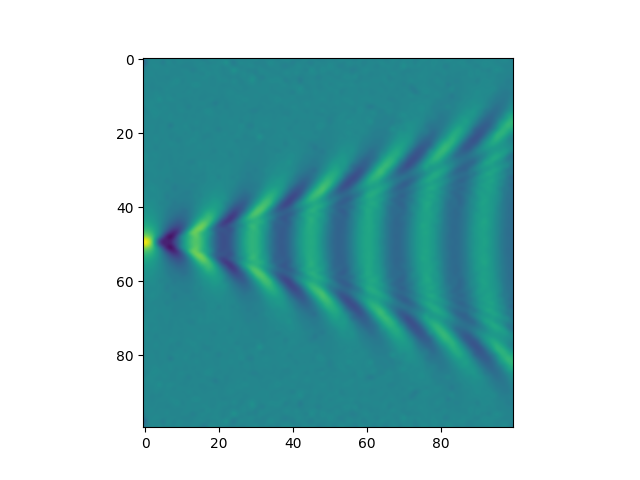The Kelvin wake pattern
Posted on 20 February 2024
An object (ship, duck, etc.) travelling across the surface of water at a constant velocity $\boldsymbol{u}$ produces a characteristic wake pattern of waves first described by Lord Kelvin.

In his model of the effect, he assumed deep, still water, neglected surface tension, and restricted the magnitude of the pressure causing the wave to be small enough that the relevant equations of motion could be treated as linear. With these assumptions, the wave vector associated with a periodic disturbance, $\boldsymbol{k} = k_x\boldsymbol{\hat{x}} + k_y\boldsymbol{\hat{y}}$ oscillates at an angular frequency of $\omega(\boldsymbol{k}) = \sqrt{g|\boldsymbol{k}|}$, where $g$ is the gravitational acceleration and the magnitude of the wave vector is related to the wavelength through $\lambda = 2\pi / |\boldsymbol{k}|$.
The change due to the waves in the water height is then
$$ z(\boldsymbol{r},t) = \int A(\boldsymbol{k}) \exp[i(\boldsymbol{k}.\boldsymbol{r} - \omega t)]\,\mathrm{d}^2\boldsymbol{k}, $$
where $A(\boldsymbol{k})$ is the amplitude of the wave with wave vector $\boldsymbol{k}$.
In the reference frame of a ship (duck, etc.) causing such a disturbance the water appears to be moving at velocity $-\boldsymbol{u}$ and $\omega(\boldsymbol{k}) = \sqrt{g|\boldsymbol{k}|} - \boldsymbol{u}.\boldsymbol{k}$. In this frame the wake appears as the interference pattern of stationary waves: $\omega(\boldsymbol{k}) = 0$ and therefore:
$$ g|\boldsymbol{k}| = (\boldsymbol{u}.\boldsymbol{k})^2 = |\boldsymbol{k}|^2 (\boldsymbol{u}.\boldsymbol{\hat{k}})^2 \;\Rightarrow\; |\boldsymbol{k}| = \frac{g}{(\boldsymbol{u}.\boldsymbol{\hat{k}})^2}. $$
That is,
$$ \boldsymbol{k} = |\boldsymbol{k}|\boldsymbol{\hat{k}} = \frac{g}{(\boldsymbol{u}.\boldsymbol{\hat{k}})^2}\boldsymbol{\hat{k}}, $$
where the unit vector, $\boldsymbol{\hat{k}} = (\cos\theta, \sin\theta)$ with $\theta$ measured with respect to the direction of $\boldsymbol{u}$: that is, $\boldsymbol{u}.\boldsymbol{\hat{k}} = u\cos\theta$.
Therefore,
$$ z(\boldsymbol{r}) = \int_0^{2\pi} A(\theta) \exp \left[ ig\frac{\boldsymbol{r}.\boldsymbol{\hat{k}}}{(\boldsymbol{u}.\boldsymbol{\hat{k}})^2} \right]\,\mathrm{d}\theta. $$
Now, assume that $A$ is constant for $-\frac{\pi}{2} < \theta < \frac{\pi}{2}$ and zero elsewhere: the ship disturbs the water equally in the immediate vicinity of its stern. Writing $\boldsymbol{r}$ in polar coordinates: $\boldsymbol{r} = r(\cos\phi, \sin\phi)$, we have
$$ \boldsymbol{r}.\boldsymbol{\hat{k}} = r(\cos\theta\cos\phi + \sin\theta\sin\phi) = r\cos(\theta - \phi) $$
and
$$ z(\phi, r) = \int_{-\pi/2}^{\pi/2} \exp\left[ ig\frac{r\cos(\theta-\phi)}{u^2\cos^2\theta} \right]\,\mathrm{d}\theta = \int_{-\pi/2}^{\pi/2} \cos\left[ \rho \frac{\cos(\theta-\phi)}{\cos^2\theta} \right]\,\mathrm{d}\theta, $$
where $\rho = rg/u^2$. There are further approximations that can yield a solution for $z(\phi, r)$ in terms of Airy functions but the code below evaluates the integral numerically and produces the following plot.

import numpy as np
import matplotlib.pyplot as plt
from scipy.integrate import quad
# Our ship (boat, duck) is travelling to the left but we're in its
# reference frame so it looks stationary at (0, 0).
nx, ny = 100, 100
xgrid, ygrid = np.linspace(0, 40, nx), np.linspace(-20, 20, ny)
X, Y = np.meshgrid(xgrid, ygrid)
# The wake wave height will be calculated at each point of this array.
z = np.empty((ny, nx))
def func(theta, rho, phi):
return np.cos(rho * np.cos(theta-phi) / np.cos(theta)**2)
for j, x in enumerate(xgrid):
for i, y in enumerate(ygrid):
rho = np.linalg.norm((x, y))
phi = np.arctan2(y, x)
z[i, j] = quad(func, -np.pi/2, np.pi/2, args=(rho, phi))[0]
plt.imshow(z, interpolation="bicubic")
plt.savefig("kelvin-wake.png")